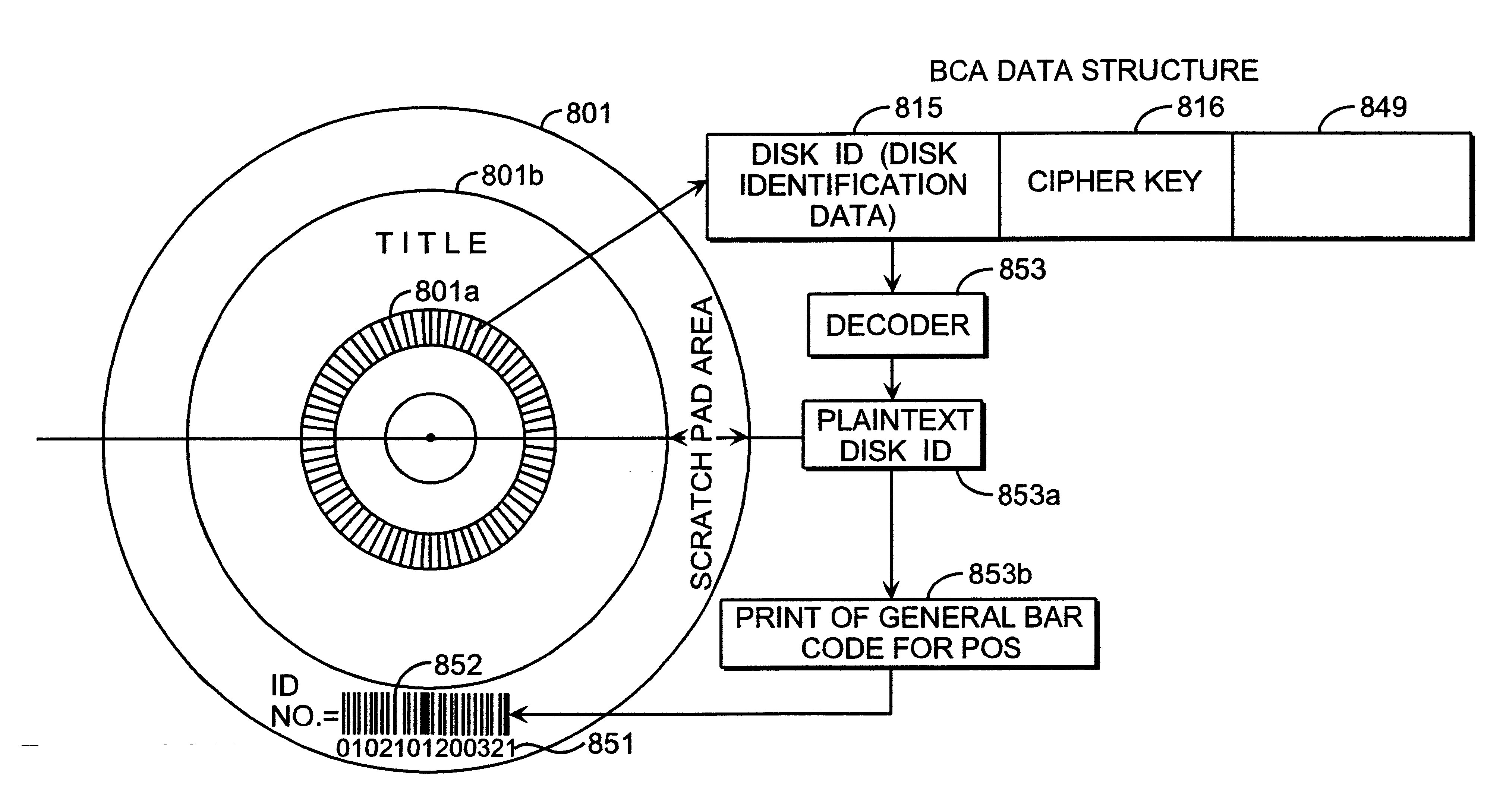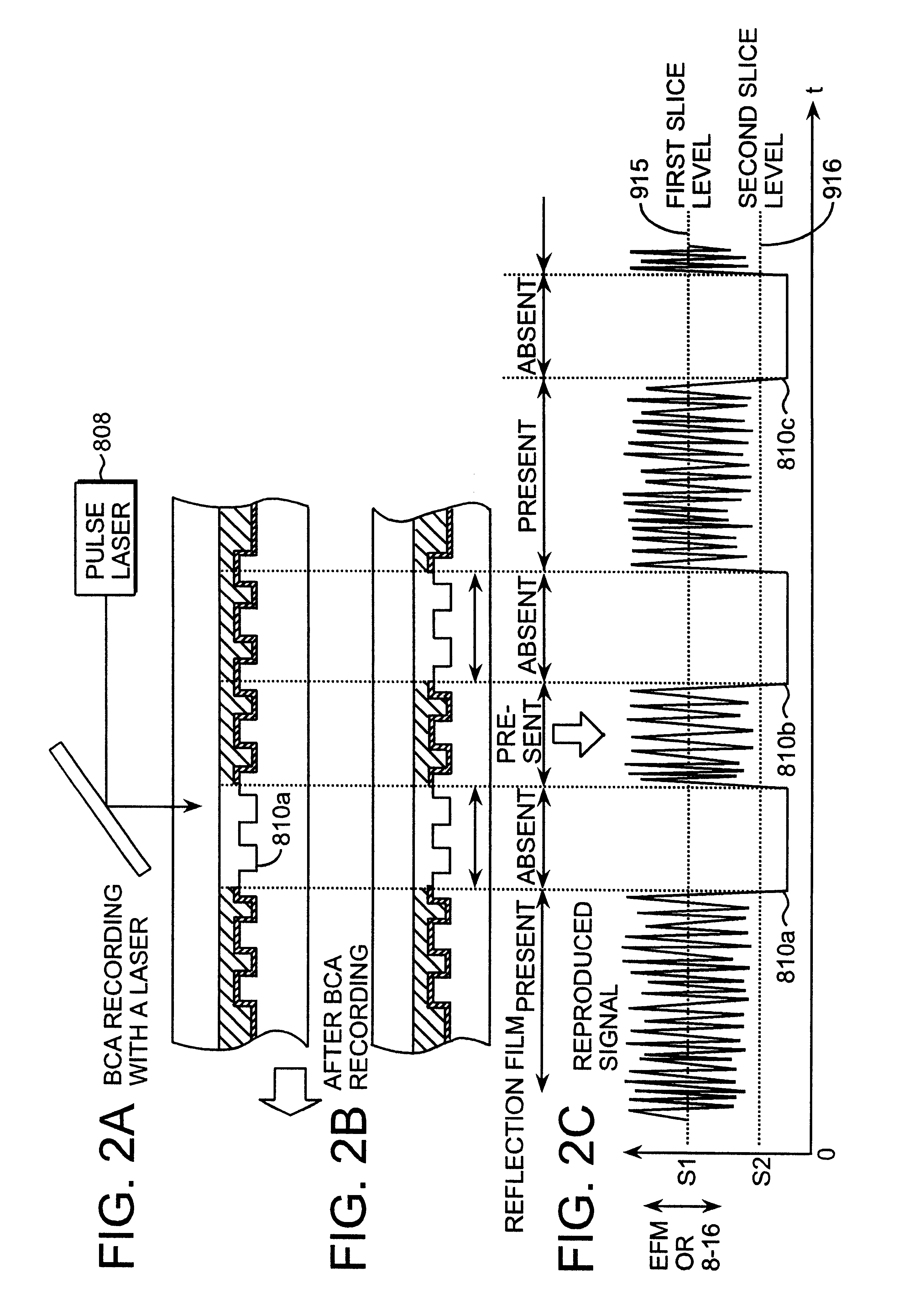[0061]If there is a number ‘n’ of, for example, 1,000
plaintext contents 850, the
cipher encoder 852 enciphers them with the first to the ‘m’th
cipher keys 851, respectively. The ciphered first to the ‘m’th contents 853, the decoding program 854a for the first to ‘m’th contents, and the second
cipher decoder 861a, which is the program for decoding the second cipher, are recorded as pits in an original disk and then molded into a substrate, and a reflecting film is formed. Thereafter, two substrates are laminated together to complete an optical disk 801. The second cipher
encoder 860 enciphers the decoding data 854 such as the
password for unlatching the ‘1-n’th, for example, the first content, and the decoding key. Recorded in advance in the BCA of the first disk are the disk's own identification data, that is, the ID 855 and the second cipher which is the enciphered decoding data. Then, in the reproducer, the second cipher is reproduced from the BCA
reproduction part 820. The second cipher decoder 861 is reproduced from the data
reproduction part 862, which reproduces the ordinary recorded data other than the BCA. Therefore, the second cipher decoder 861 is used to decode the second cipher, reproducing the ID 855a and ‘1-n’th
password 854a. The cipher decoder 855b uses the decoding program 854a for the ‘1-n’th content reproduced from the data
reproduction part 862, and uses the ID 855a and password 854a to decode the first cipher, obtaining the
plaintext 855c of the ‘1-n’th content and the identification data 855a. For a
personal computer, the content and ID are recorded on the hard disk 863. This ID 855a checks to determine if there in no same ID on a network when the program has started, and the ID 855a actuates the network protection. It is therefore possible to prevent the
software from being illegally installed. This is yet another
advantage of the present invention. For example, if 1,000 enciphered contents are stored and decoding data such as a password corresponding to a particular
software application are recorded on an original disk, this is equivalent in substance to the preparation of an optical ROM disk for a particular content. It is possible to obtain with one original disk the same effect as in the case where original disks for 1,000 kinds of
software are
cut. It is therefore possible to reduce the costs and time or labor for preparing an original disk.
[0062]Described with reference to FIG. 10 is the procedure is for enciphering contents with a BCA when recording them on a RAM disk. First, the BCA reproduction part 820 reproduces the BCA data from the RAM disk 856, outputs an ID 857, and sends it through the interfaces 858a and 858b and the network to the encipherment part 859. The cipher
encoder 861 of the encipherment part 859 enciphers contents 860 or scrambles picture and sound signals by means of a key including the ID 857. The enciphered contents are sent to the recorder / reproducer, where the recording circuit 862 records them on the RAM disk 856.
[0063]Next, when this
signal is reproduced, the data reproduction part 865 demodulates the main data to reproduce the enciphered
signal, and the cipher decoder 863
decodes the reproduced
signal. The BCA reproduction part 820 reproduces data containing the ID 857 from the BCA area of the RAM disk 856. The reproduced data is sent as part of the key to the cipher decoder 863. If normally copied, the cipher key recorded in the RAM disk is a normal disk ID. The RAM disk ID, also, is a normal disk ID. Therefore, the cipher is decoded or descrambled to output the
plaintext 864 of the ‘1-n’th content. For a graphic data, for example, the MPEG signal is extended to obtain a picture signal.
[0064]In this case, the disk ID is the key for encipherment. Because each disk is unique, it can be copied on only one RAM disk,
[0065]If a disk ID is copied from a normal RAM disk to another RAM disk, ID1 which in the original normal disk ID differs from ID2 which is the disk ID of the other, unauthorized, RAM disk. If the BCA of the unauthorized RAM disk is reproduced, ID2 is reproduced. The contents are ciphered with ID1, however, so that, even if unlatching is attempted with ID2 at the cipher decoder 863, the cipher is not decoded because the key differs. Thus, the signal of the illegally copied RAM disk is not output, so that the copyright is protected. The present invention uses a disk ID
system. Therefore, by reproducing with any drive the normal RAM disk copied normally only once, it is possible to unlatch the cipher. The encipherment part 859 may, in place of the center, be an IC card with a cipher encoder.
[0066]With reference to the
block diagram of FIG. 11 and the
flowchart of FIG. 12, the method of preventing
copying will be described. At Step 877a, the installation program is actuated. At Step 877b, the BCA reproduction part 820 outputs the ID of the auxiliary data from the laminated optical disk 801. At Step 877d, the data reproduction part 865 reproduces the contents and network check software 870 from the main data. The contents and the ID 857 are recorded on the HDD 872. At Step 877c, the ID 857 is encoded with a particular secret cipher so as not to be altered illegally, and is recorded as a soft ID in the HDD 857. Thus, the soft ID 873 is recorded together with the contents on the HDD 872 of a
personal computer 876. Here described is the case where the program is started at Step 877f of FIG. 12. When the program is started, the procedure goes to Step 877g, where the soft ID 873 of the HDD 872 is reproduced, and the soft ID 873a in the HDD 872a of another
personal computer 876a on a network 876 is checked through the interface 875. At Step 877h, a check is made to judge if the soft ID 873a of the other personal computer and the soft ID 873 are the same number. If so, the procedure goes to Step 877j, where the start of the program of the personal computer 876 is stopped or a warning message is displayed on the screen.
 Login to View More
Login to View More  Login to View More
Login to View More 


